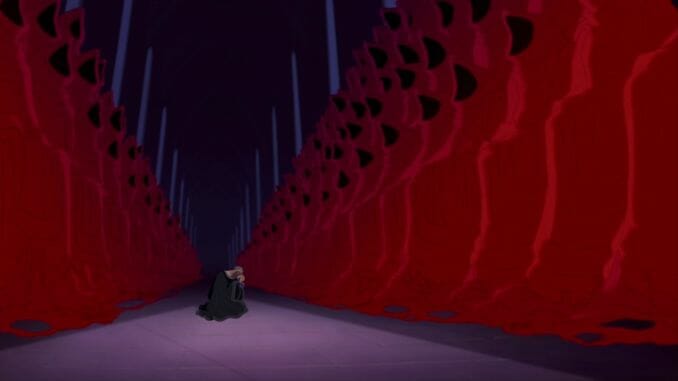“Hellfire” and Brimstone: The Hunchback of Notre Dame Saw Disney Take on Religion 25 Years Ago

Two and a half decades before Pixar literalized a Soul, The Hunchback of Notre Dame saw Disney take on religion. While the ultra-dark 1996 film initially seems like a bit of a revision to the complexly anti-clerical Victor Hugo’s novel, it ends up having more in common with Ken Russell’s The Devils than Hercules’ Grecian musical fun. Lust, accusations of witchcraft and a hypocritical church more interested in power and politicking than caring for those that need it most dominate Disney’s most ideologically ambitious project of its Renaissance. Usually there’s no message greater in these movies than that Disney magic—or its corporate subsidiary, True Love—is the highest power in the land. But Hunchback knows God, knows Heaven, knows the Devil. It faces religion as squarely as the company has ever done and, despite its surface appearances, adapts a scathingly faithful look at faith.
But Disney did do some to mitigate any immediate offense. Claude Frollo, one of Disney’s most evil villains, has been vaguely rewritten from Hugo’s archdeacon to the anachronistic Minister of Justice. But it’s in name only—he’s fanatically devout, filled with angry-horny self-loathing, and powerful enough to actually put the warped faith on display throughout the film into action. “We did everything visually to indicate that he was supposed to be a priest,” said head of story Will Finn. Two years earlier, The Lion King’s Scar pulled off a memorable, intimate murder like Claudius before him; Frollo literally kicks things off with a killing and goes from there. No talking animals here, just a hate crime on the steps of a cathedral.
Frollo’s is a religious doctrine that is inherently racist, one that considers Romani “heathens” as nothing but termites gnawing away at the moral fiber of the community. Frollo describes their sanctuary, the Court of Miracles, as a “nest” and a chuckling Tony Jay takes an evil little pleasure in his ironic delivery of “miracles.” Frollo’s hate has pushed this district beyond the Parisian slums and into the catacombs—the entrance to which, in a graveyard, shows more crosses on screen than any other point of the film. These poor and weak are far holier in the film’s eye than the fire-and-brimstone Frollo with his massive gumball-jeweled rings. His sort of scared-straight zealotry is even mocked in Quasimodo’s alphabet training gag: Abomination, Blasphemy, Contrition, Damnation, Eternal Damnation.
The villain is far more representative of the film’s corrupt church—populated by selfish parishioners that pray for “wealth,” “fame,” “for glory to shine on my name” and “love I can possess” in the eavesdropping “God Help the Outcasts” song—than the film’s pandering creation of an effectively useless archdeacon. This facile figurehead (a representative of passive, buck-passing faith) gets shoved around by Frollo and is immediately outshone by protagonists like soldier-turned-hero Phoebus, whose morality results in actions (giving charity, saving peasants from Frollo’s arson) rather than empty platitudes. While there is the barest of sanctuary given by the archdeacon’s side of organized religion, it is almost entirely impotent in the face of its worst abusers.
-

-

-

-

-

-

-

-

-

-

-

-

-

-

-

-

-

-

-

-

-

-

-

-

-

-

-

-

-

-

-

-

-

-

-

-

-

-

-

-








































